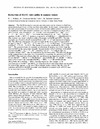Identificador persistente para citar o vincular este elemento:
https://accedacris.ulpgc.es/jspui/handle/10553/49837
| Título: | Reduction of Fe(III) with sulfite in natural waters | Autores/as: | Millero, F. J. Gonzalez-Davila, M. Santana-Casiano, J. M. |
Clasificación UNESCO: | 251002 Oceanografía química | Palabras clave: | Iron(Iii) Sulfur(Iv) Complexes Mineral Aerosol Solutions Aqueous S(Iv) Oxidation Metal-Ions Catalyzed Autoxidation, et al. |
Fecha de publicación: | 1995 | Editor/a: | 0148-0227 | Publicación seriada: | Journal Of Geophysical Research-Atmospheres | Resumen: | The Fe(Ill) in marine aerosols and rainwaters can be reduced to Fe(II) by photochemical processes and by reactions with sulfite. In this paper, measurements of the rates of reduction of nanomolar levels of Fe(III) with sulfite (without 0 2) have been determined in NaCl and seawater solutions as a function of temperature (Oº to 40ºC), pH (2 to 6.8), ionic strength (/ = 0.1 to 6 M), and composition (Na + , Mg 2+ , Ca 2+ , F -, Cl - , Br-, HCO3-, so]-). The overall rate constant (k, M-1 min - I) for the reaction, Fe(III) + S(IV) products, is given by d[Fe(IIl)]/dt = -k[Fe(Ill)] [S(IV)]. The reaction was found to be first order with respect to Fe(III) and S(IV). The rate constants as a function of p H increased from a p H = 2 to 4 and decreased at higher pH. The effect of temperalure and ionic strength on the rates could be represented by log k = log k º + AI º·5 J( l + I º ·5), where A = - l. l in NaCI and -2.2 in seawater and log k º = 25.39 - 6,323/T. The energy of activation was found by 121 ± 6 kJ mo1-1 . The measured rates in seawater as a function of salinity were lower than the rates in NaCI at the same ionic strength. Measurements in NaCl solutions with added sea-salt ions (Mg 2+ , Ca 2 + , p-, Br-, and SO¡-) at pH = 3.5 indicate that the formation of inert FeF 2+ may be responsible for the lower rates. The effect of changes in the composition on the rates was interpreted by examining the speciation of Fe(III) and S(IV). This analysis indicates that the rate-determining steps from a pH of 2.5 to 4.0 are FeOH 2+ + HSO 3 - - HOFeSO3H + and HOFeSO 3H + FeOH + + HSO 3 · and at pH of 4 to 6, the reactions Fe(OHh+ + HSO3- - (HO)iFeSO3 H and {HO)zFeSO3 H Fe(OH)i + HSO3• become important. The changes in the concentration of FeOH 2+ and HSO 3 - as a function of pH and composition can account for most of the changes in the rates. These kinetic studies indicate that the rates of reduction of Fe(l11) with S(IV) in acidic water droplets at natural levels of S(IV) may be an important source of Fe(II). | URI: | https://accedacris.ulpgc.es/handle/10553/49837 | ISSN: | 2169-897X | DOI: | 10.1029/94JD03111 | Fuente: | Journal of Geophysical Research. Atmospheres [ISSN 0148-0227], v. 100, p. 7235-7244 |
| Colección: | Artículos |
Citas SCOPUSTM
43
actualizado el 08-jun-2025
Citas de WEB OF SCIENCETM
Citations
37
actualizado el 08-jun-2025
Visitas
121
actualizado el 30-nov-2024
Descargas
511
actualizado el 30-nov-2024
Google ScholarTM
Verifica
Altmetric
Comparte
Exporta metadatos
Los elementos en ULPGC accedaCRIS están protegidos por derechos de autor con todos los derechos reservados, a menos que se indique lo contrario.
